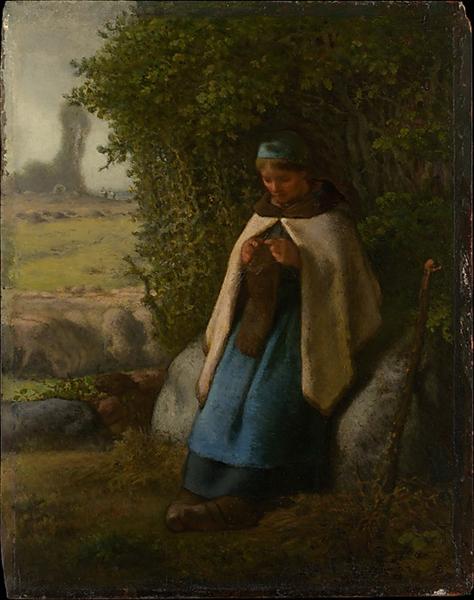Beskrivning
Jean-François Millet's painting "Shepherdess Seated on a Rock" from 1856 is a work that encapsulates the essence of naturalism and the rural life that the artist sought to portray with touching sincerity. In this work, a young shepherdess sits on a rock, her figure centralized in a landscape that reflects the calm of the French countryside. The composition is simple yet deeply effective; the shepherdess is the focal point, representing the intimate connection between humans and nature.
The figure of the shepherdess is both robust and serene, dressed in a white blouse and a skirt of a uniform tone that highlights the luminosity of her skin. The expressiveness of her face, in a moment of rest, suggests a sense of contemplation. This portrait of peasant life, so characteristic of Millet, is not only a representation of physical labour, but a celebration of the dignity and beauty of the rural world. Through her posture, the young woman conveys a sense of tranquillity and connection with her surroundings; the rock, as well as being the support of her rest, symbolises the durability and strength of country life.
The colours used by Millet are soft and earthy, a reflection of the artist's approach to a more naturalistic use of colour. The palette is made up of brown and green tones, evoking earth and vegetation, while the sky, a soft blue, adds luminosity to the scene. This colour choice not only reinforces the rural theme, but also establishes a serene atmosphere, conveying a sense of peace and content. Millet uses light in a way that softens the shadows and gives volume to the figure of the shepherdess, highlighting the texture of her clothing and her hair, which falls freely in a gesture that suggests naturalness.
Jean-François Millet, one of the founders of the realist movement, was known for his deep appreciation for the life of peasants and for depicting their labor with dignity. The "Shepherdess Seated on a Rock" is a testament to this vision, in which the artist elevates the figure of the rural worker to an almost mythical level. Through this work, Millet not only captures a moment, but also tells a story about work, community, and the relationship between man and the land.
It is interesting to note that Millet, active in the second half of the 19th century, was part of an artistic shift that sought to move away from idealized Romanticism to find beauty in the everyday and the ordinary. This shift is also seen in contemporary works that explore rural life, where a more authentic connection with the peasant environment is sought, something that has influenced many later artists.
The “Shepherdess Sitting on a Rock” remains relevant in the context of contemporary art for its ability to evoke a deep empathy for the human condition and an insight into the human being’s place in nature. Through its subtle composition and sublime treatment of color, Millet creates a work that invites the viewer to reflect on the fragility and strength of life itself. In this painting, the shepherdess is not only a symbol of a time and place, but a timeless figure that represents a legacy of respect for the land and its people.
KUADROS ©, a famous painting on your wall.
Hand-made oil painting reproductions, with the quality of professional artists and the distinctive seal of KUADROS ©.
Painting reproduction service with satisfaction guarantee. If you are not completely satisfied with the replica of your painting, we will refund 100% of your money.

